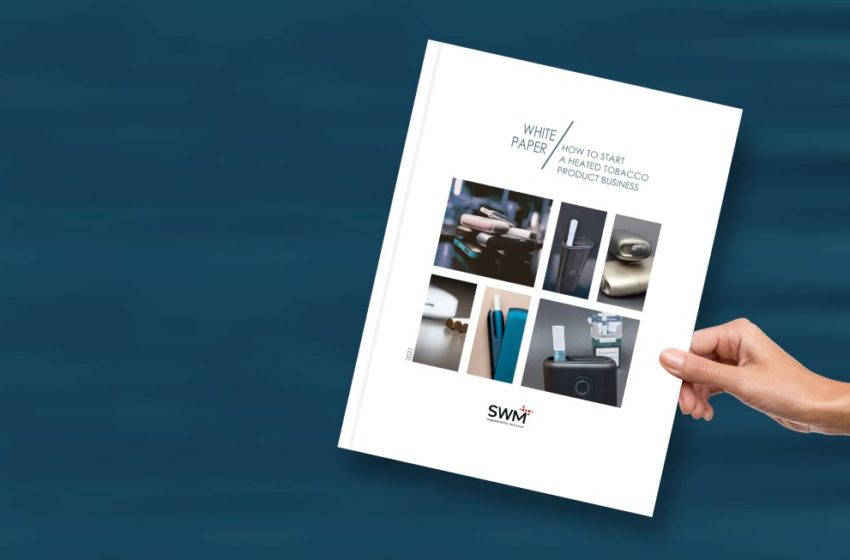
SWM has published a manual to help regional manufacturers quickly launch tobacco-heating products.
By George Gay

Bruno Stefani told me recently that his company’s aim was to help other companies develop, manufacture and market heated-tobacco products (HTPs). This came as no surprise, in fact; he is, after all, the HTP manager of SWM’s Reduced-Risk Products division, so what he said was more or less a statement of the division’s raison d’etre. But he went on to explain that the division’s focus was on regional cigarette manufacturers that had previously not entered the HTP market and that the aim was to have them launch products within 18 months to 24 months while continuing to operate in much the same way as they do when manufacturing combustible cigarettes. Each step of the process seems to have been designed with simplicity in mind and with the focus on targeting HTP products aligned with individual manufacturers’ brand profiles. Now, given the history of HTPs, which overall and until recently comprised about 30 years of market tests and failures, news of such a straightforward, rapid and all-encompassing offer did come as something of a surprise.
When the first commercially successful HTP products started to appear on the market, there was a veil of secrecy around them that most of us could penetrate only dimly. Of course, the veil started to lift as these products came under the scrutiny of those who were more qualified than most of us to figure out why they had been designed as they had been and how they performed as they did. And it started to lift further as the interests of those manufacturing these reduced-risk products were aligning with the release of information that was likely to increase their marketability in the eyes of consumers and, potentially, regulatory authorities.
It is not surprising, therefore, that now, much information about HTPs can be gleaned from the internet, though, I would suggest, it is surprising that it is possible to visit a website that outlines the way in which anybody interested in these once obscure products and with the necessary financial backing can be guided, from concept to marketplace, through the steps needed to become a manufacturer and supplier of such products. But, in fact, SWM, which has much expertise in the components that come together to make up an HTP, provides on its website a white paper that does just that.
The white paper, which is clear and concise, includes, in addition to an introduction and executive summary, chapters on what companies need to know before launching an HTP and dealing with an overview of the HTP market; eight reasons to make the leap into HTPs; overcoming obstacles; designing the heating device; designing the stick; building a blend; risks and regulations; and HTPs and the environment. There is also a chapter on expert solutions, and it is worth mentioning that SWM has invested €12 million ($12.88 million) in heat-not-burn R&D since 2013, as part of which it has assessed more than 40 different single tobacco grades under aerosol conditions. It has developed a unique puff-per-puff aerosol analyzer; it has presented at Coresta three scientific studies on HTPs; and, overall, it has more than eight years of HTP scientific and manufacturing expertise behind it.
Stefani told me during a telephone interview in early March that SWM offers a four-step process for developing and marketing an HTP from scratch. At its heart, the process involves providing a customer with know-how and access to ready-made components while avoiding tricky patent issues. The first step, discovery, is the one in which SWM demonstrates to a potential customer the workings and benefits of a number of HTP products. The second step, validation, involves a proof of concept in which characteristics, such as the taste profile and nicotine delivery level, are finalized in respect of a prototype.
The third step, industrialization, deals with how to manufacture and maintain the quality of the consumable sticks using the assets already available to the manufacturer. And the fourth step, the future, concerns preparing, immediately after launch of the first HTPs, the next generation of such products, which need to be placed on the market about every six months to keep the product portfolio looking fresh but which might involve only minor brand extensions.
To ensure a fast HTP development phase, SWM’s process is built around an already designed device and consumable stick. The device, which has been designed and would be manufactured by a third party with which SWM has worked and to which it would provide introductions, uses an “external” or oven system to heat the aerosol-generating material rather than an “internal” blade or pin. Choosing the external rather than the internal heating system reduces hugely the investment required because, whereas in the case of the latter, a greenfield plant must be constructed, the former allows a manufacturer to use, perhaps with minor modifications, its existing machinery. The third-party device supplier owns the patent to the device and ordinarily would be responsible for the after-sales obligations that attach to the supply of such electronic equipment.
At the same time, SWM can provide introductions to a filters company and to a machinery company in the case that modifications must be made to equipment while it is able to supply the consumable stick’s reconstituted tobacco for which it holds the patents.
But, in the end, it is down to the customer to mix into its primary department the reconstituted tobaccos specifically designed for HTP applications and other materials to produce personalized blends, much as it would do when making combustible cigarettes: adding other components, such as casings and flavors and even other reconstituted botanicals that, again, are designed specifically for HTP applications and that can be supplied by SWM. And it is, of course, down to the customer to sign off on the sensory experiences provided by the product.
Staying Competitive
Although the process sounds straightforward, the question arises, I suppose, as to why regional players should become involved in HTPs and if they should become involved, why, in general, they haven’t so far, even though, in conversations with Stefani, many have expressed considerable interest. There are at least three answers to the second question, one of which has to do with the disruptions caused by the Covid pandemic. Another reason has to do with some manufacturers already being involved in other projects that have left them for the time being without the resources necessary to embrace HTPs. And for some, there is no sense of urgency in moving to HTPs because, with the major manufacturers concentrating on new-generation products, the regional players are performing well on the market for combustible cigarettes and have not felt the chill wind of decline.
But it seems likely that if these regional players are to stay competitive in a world where combustible cigarettes are giving way to new-generation products of various kinds, they will need to get on board with HTPs and probably sooner rather than later. SWM says the combustible cigarette market is suffering a steady attrition that amounted to an estimated compound annual growth rate (CAGR) of about minus-4 percent between 2016 and 2022. Over the same period, HnB products enjoyed an estimated CAGR of about 70 percent, and, in some countries, the market share of HTPs was above 10 percent by the end of 2022. Within the EU, where most but not all of the target regional manufacturers operate, the cigarette/HnB transfer rate between 2016 and 2020 was plus-35 percent, meaning that for every 100 cigarette sales lost, HTP sales grew by 35 sticks.
Further, SWM estimates that the overall HTP CAGR between 2021 and 2027 is likely to be 15 percent to 20 percent while the CAGR for HTPs using external heating systems will be about 20 percent to 25 percent given that they are starting from a lower volume base.
Of course, confidence in the future for these devices is provided by the fact that, in many markets, they stand at a tax discount to combustible cigarettes, providing a potential retail price advantage that, in the case of HTPs with external heating systems especially, is bolstered by the relatively low cost of manufacturing disposable sticks. Such confidence must also be seen in the context of the investments that have been made in them and that is continuing to be made in them by the major players. And it is likely, too, that the entry into this market segment of regional players will build product exposure and market momentum.
The case for HTPs can be argued from a negative perspective as well. If a consumer of a regional player’s combustible cigarettes decides she wants to move to a less risky product, she will move to the product of a competitor if the regional manufacturer doesn’t offer a suitable product. And this would be an avoidable loss for the manufacturer in question. While it is not possible for a manufacturer to develop HTPs that exactly mimic the characteristics of its combustible brands, it can get close enough to present devices as new formats offering fresh experiences. This product/brand continuity, if you like, is important because while a consumer might be looking to move to a less risky product, she probably wants, too, to move to one manufactured by a company she already trusts.












